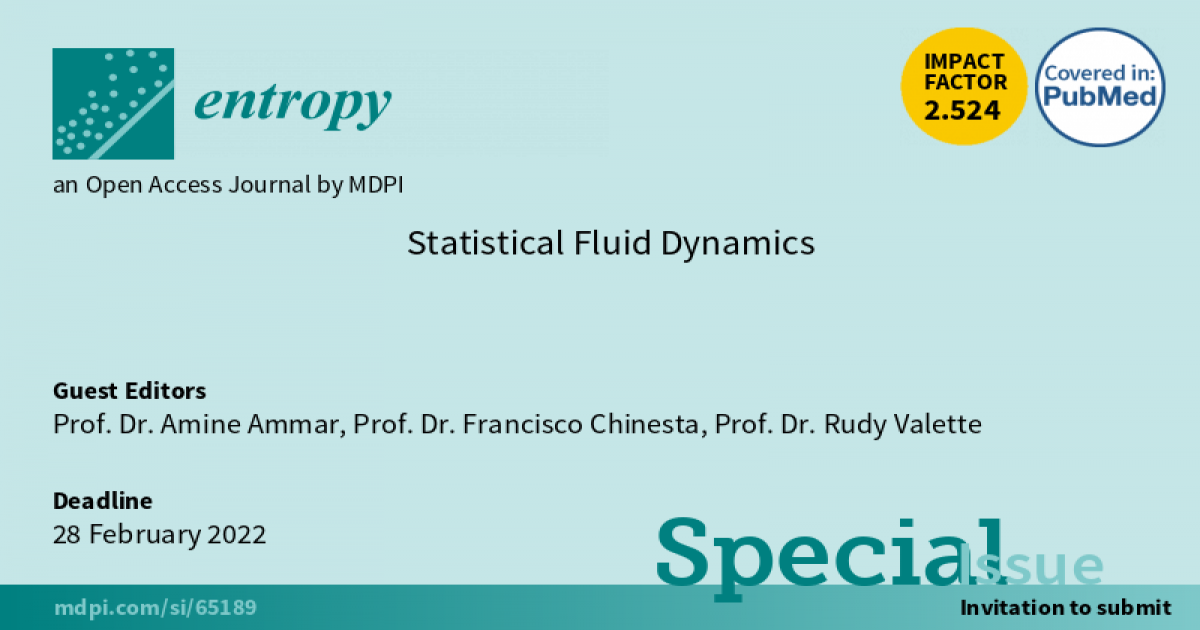- 2.0Impact Factor
- 5.2CiteScore
- 22 daysTime to First Decision
Statistical Fluid Dynamics
This special issue belongs to the section “Statistical Physics“.
Special Issue Information
Dear Colleagues,
Modeling micrometric and nanometric suspensions remains a major issue. They help to modify in a controlled way the mechanical, thermal, and electrical properties, among others, of the suspensions and then of the resulting product when considered in material forming. In some cases, they can contribute to improving the performance of energy transport. An optimal use of these products is based on an accurate prediction of the flow-induced properties of the suspensions and consequently of the resulting products and parts.
Particles suspended in a viscous medium tend to modify the behavior. The final properties of the resulting microstructured fluid or solid become radically different from the simple mixing rule. There are numerous works addressing homogenization strategies for systems consisting of perfectly of dispersed particles in a matrix. However, in most cases, particles aggregate or sediment, or exhibit strong induced anisotropy. The microscopic description, despite being the finest one, is too heavy from both computational and experimental points of view. For this reason, coarser descriptions are sometimes preferred. Even if they are less accurate, they lead to faster simulations.
This Special Issue is open to all contribution in this field: From fine to coarse descriptions, from numerical to experimental approaches, etc. Numerical contributions may include molecular dynamics, Brownian, or kinetic theory approaches. Experimental papers are also welcome, especially when they discuss controversial behaviors. The applicative dimension is also a point of interest.
Prof. Dr. Amine Ammar
Prof. Dr. Francisco Chinesta
Prof. Dr. Rudy Valette
Guest Editors
Manuscript Submission Information
Manuscripts should be submitted online at www.mdpi.com by registering and logging in to this website. Once you are registered, click here to go to the submission form. Manuscripts can be submitted until the deadline. All submissions that pass pre-check are peer-reviewed. Accepted papers will be published continuously in the journal (as soon as accepted) and will be listed together on the special issue website. Research articles, review articles as well as short communications are invited. For planned papers, a title and short abstract (about 250 words) can be sent to the Editorial Office for assessment.
Submitted manuscripts should not have been published previously, nor be under consideration for publication elsewhere (except conference proceedings papers). All manuscripts are thoroughly refereed through a single-blind peer-review process. A guide for authors and other relevant information for submission of manuscripts is available on the Instructions for Authors page. Entropy is an international peer-reviewed open access monthly journal published by MDPI.
Please visit the Instructions for Authors page before submitting a manuscript. The Article Processing Charge (APC) for publication in this open access journal is 2600 CHF (Swiss Francs). Submitted papers should be well formatted and use good English. Authors may use MDPI's English editing service prior to publication or during author revisions.
Keywords
- suspensions
- microparticles
- nanoparticles
- rheology
- thermal properties
- mechanical behavior
- molecular dynamics
- kinetic theory

Benefits of Publishing in a Special Issue
- Ease of navigation: Grouping papers by topic helps scholars navigate broad scope journals more efficiently.
- Greater discoverability: Special Issues support the reach and impact of scientific research. Articles in Special Issues are more discoverable and cited more frequently.
- Expansion of research network: Special Issues facilitate connections among authors, fostering scientific collaborations.
- External promotion: Articles in Special Issues are often promoted through the journal's social media, increasing their visibility.
- e-Book format: Special Issues with more than 10 articles can be published as dedicated e-books, ensuring wide and rapid dissemination.

